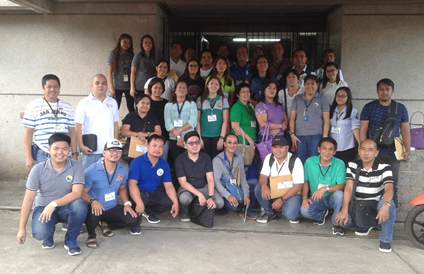Training of enumerators on geo-tagging and parameter measurement of Small Scale Irrigation Projects (SSIPs) was organized to facilitate and fast-track the conduct of survey in Laguna province. Prior to the conduct of actual training, the project team prepared communication letters to all the cities and municipalities in the province requesting an agricultural technician involved in the irrigation activities (specifically on SSIPs) of their respective municipality/city. Training kits containing IEC materials and survey instruments of the project were also prepared to help the participants understand the training. The training was delivered by the project team members from IAE and BIOMECH. It was held on February 26, 2018 at the AMTEC conference room, CEAT, UPLB. Figure 1 shows the project team members together with the training participants.
Figure 1. Project team members and training participants in Laguna.
The first part of the training consisted of lectures on the different kinds of SSIPs (shallow tube well (STW), diversion dam (DD), small farm reservoir (SFR), small water impounding project (SWIP), pump irrigation system open source (PISOS), and spring development (SD)) and geo-tagging of SSIPs using smart phones (Figure 2 and 3). It also included lecture on the use of the survey instruments (farmer questionnaires and data sheets) of the project (Figure 4).
Figure 2. Lecture presentation on the different kinds of SSIPs.
Figure 3. Lecture presentation on geo-tagging of SSIPs using smart phones.
Figure 4. Lecture presentation on the use of the survey instruments.
For the second part of the training, actual demonstrations on how to gather primary data for each SSIP and geo-tagging was done. The participants were brought to the Hydrology Laboratory of the Land and Water Resources Division, IAE, CEAT to show and simulate flow measurement on rivers and irrigation canals (Figure 5). The trainees were also brought to an STW site in the Central Experiment Station (CES) farming systems area to determine the water depth level of the well (Figure 6). Using their smart phones, the training participants determined the GPS location of the STW (Figure 7).
Figure 5. Actual demonstration on flow measurement using the flume.
Figure 6. Actual demonstration on water depth level in an STW.
Figure 7. Actual demonstration of determining the GPS location of the STW.









